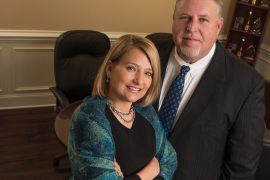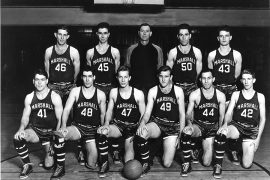State leaders are planning to move Huntington into the future by looking onward and upward
By Abbey L. Link
HQ 3 | SPRING 1990
Imagine catching a direct flight from this area to nearly anywhere in the nation, to nearly anywhere in the world, even. Long delays in nearby hubs would exist only in memory as would the hassle and the inconvenience of changing planes one or more times before reaching your destination.
Sounds like a dream. Yet, it’s a dream that may well become reality this decade as local and state officials band together to bring quality air service to the region.
Presently, these officials are concentrating their efforts on two fronts – the revival of a regional airport idea and the attraction of a wayport to this part of the state.
Both ideas have merit. A regional airport, if built in a central location that would benefit the Huntington, Charleston and Ashland, Ky., areas, would consolidate air service and potentially lure additional carriers to the state. Designed to alleviate congestion at the nation’s hub airports by serving primarily as a transfer point for passengers and cargo, a way-fort would have the same effect on the quality of the state’s air service, except the federal government would pick up approximately 90 percent of the tab.
U.S. Rep. Bob Wise, D-W. Va., is perhaps the most vocal proponent in the movement to resurrect the regional airport idea.
“You don’t have to sit through too many canceled flights or walk through the crowded airport in Charlotte, N.C., to see that we need a regional airport policy,” Wise says.
Support for a regional airport isn’t new to the area. In the early 1960s, a proposed regional airport facility, Midway Jetport, enjoyed tremendous public support. The jetport, which was to have been located about 2.3 miles north of I-64 near Hurricane, would have included two runways and would have cost between $16 and $20 million in 1966.
But, hopes for a regional airport were quashed when Kanawha Vounty voters defeated a bond levy in 1967 that would have helped pay for the project. Despite the fact that voters in the other counties involved – Cabell, Putnam and Boyd (Ky.) – had approved the floating of $6 million in bonds, the project died because of Federal Aviation Administration stipulations.
As a condition for contributing about 50 percent of the funding for the proposed Midway Jetport, the FAA, despite its strong support for the project, said that both Cabell and Kanawha counties had to sponsor the project. Though Midway Jetport continued to be discussed publicly well into the next decade, the project never regained the momentum it had in the 1960s.
“There have been tremendous improvements in the relations between Huntington and Charleston since 1965 (when the Midway Jetport idea began catching on),” Wise says. Society has changed a lot since 1965. We now have regular flyers, frequent flyers and the competition between airlines has dissipated.”
Publicly, Huntington Mayor Robert R. Nelson, who was a staunch supporter of the Midway Jetport, has voiced support for a revival of the regional airport idea. Charleston Mayor Chuck Gardner has been more guarded in his response.
Now is the time to act, Wise says. “This is our last chance to look at this. The land is disappearing. If we’re going to move, we have to move now. Congress is building airports again. There are billions of dollars built up in the aviation trust. This is a new era of airport construction. The question is are we poised to take advantage of it?”
U.S. Rep. Nick Rahall, D-W.Va., and others say it’s not a matter of whether the state is ready, but whether the regional airport should be given priority over the way-fort concept. Originating at the FAA in the 1980s, the way port concept calls for four to six “super hubs” to be built in rural areas as a way to decrease congestion at the nation’s hub airports. These way ports would serve mainly as a transfer point for passengers and cargo, according to a written report by Dr. Christine L. Barry, vice-chairman of Cabell County’s Wayport Committee.
Proponents argue these “superhubs” are the answer to the nation’s aviation problems. According to Barry’s report, the number of air travelers increased by 65 percent in the 1980s, which the number of large airports remained the same. The report states: “Current FAA projections are that US traffic will increase from an estimated 476 million passengers in 1988 to 820 million in the year 2000. Already 11 major airports are experiencing chronic delays and 29 would be affected by 1996.”
For West Virginia, a way-fort would mean jobs, lots of jobs. Between 5,000 and 15,000 jobs possibly would be generated by a wayport. More importantly, these wouldn’t be minimum wage jobs.
The U.S. Postal Serice has indicated that mail-sorting facilities will be located at all of the hubs. In addition, other delivery services, such as the United Parcel Service and Federal Express, probably also would locate at these hubs, says Jim Casto, associate editor of The Herald-Dispatch. Construction would be the first industry to benefit fro the wayport. Each wayport is expected to cost about $1.5 to $2 billion. Building the facilities would be a colossal undertaking. Presently, early wayport specifications call for all of the “superhubs” to be designed alike. Each wayport would have eight runways, including four diagonal and four parallel runways. Terminal areas will be large enough to handle about 25,000,000 passengers a year. The minimum amount of land needed to build a wayport is estimated at 15,000 to 20,000 acres.
To put the dimensions in context, each wayport would be about the size of Atlanta’s Hartsfield International Airport. The second busiest airport in the United States, Hartsfield has 147 gates and four runways, which handle a take-off or landing every half minute.
Presently, the wayport concept still is in the discussion stages. The House of Representatives is conducting hearings on the idea and the Bush Administration has yet to indicate whether it supports the wayport concept. Casto, who along with Matt Miller and Larry Salyers spoke at a House subheading on the wayport concept in February, says he believes Congressional support for the idea is growing. “My own impression is that support in the Congress is strong and is getting stronger.”
Matt Miller, chairman of the Huntington Area Chamber of Commerce, says he believes the representatives he spoke to were receptive to the idea of a wayport, but that the airline industry is the huge obstacle the idea must hurdle.
“The representatives from, the airline associations are not for the wayport concept,” Miller said. “That’s probably the biggest obstacle.”
Barry concurs. In her report, she writes: “Wayports will not be built in the U.S. unless airlines agree to use them.”
Airline opposition to the wayport concept is a matter of turf. For example, according to Barry’s report, Northwest Airlines has an 85 percent market share of Memphis, Tenn., an 80 percent market share at Minneapolis.St. Paul, Minn., and a 62 percent market share at Detroit Metro.
“This points to the fact that airline carriers are worried about losing originating traffic to a way-fort,” she writes. “They’re also paranoid about competing hubs. Most hubs are dominated by a single airline. Peaceful co-existence – which transfers into a dearth of fare rivalry – is prevalent at those hubs shared by two carriers.”
But, Congress may well go ahead with the way port plan. Del. Rick Houvouras, D-Cabell, along with House Speaker Chuck Chambers, D-Cabell, pushed through legislation in the House during the 1990 session that calls for “the establishment of a revolving loan fund for the development of wayports and to establish a commission to propose areas suitable for the location of such wayports.”
“What we set out to do was to write a piece of legislation that will give a way-fort committee both bonding authority and the power of imminent domain if and when the federal government decides to move ahead,” Houvouras said.
West Virginia is now in the forefront of the movement to attract wayports. Hoping to lure the proposed Northeast hub, the state is the first in the nation to establish a Wayport Authority that has the ability to go to work immediately to build a wayport. In addition to the power of imminent domain, the Wayport Authority has the power to determine the site and to handle all negotiations with the federal government.
“For years,” Houvouras said, “projects like this have literally flown over us.
“We’re not going to be left in the dust this time, “ Houvouras added. This time, we’re creating some dust of our own.”
Other states that have taken steps to lure a wayport include Kansas, Michigan, Mississippi, Nebraska, North Dakota, Oklahoma and Texas.
West Virginia’s legislation also calls for the wayport to allow for public access, meaning that travelers in this region could board planes there. “We has passed the most comprehensive piece of legislation in the country in terms of wayport preparedness,” Houvouras said.
Casto agrees. “It’s a long shot. But, for once, we’re in the front go the pack. We’re not bringing up the rear.”
Money to build wayports already is available in the Airport and Airways Trust Fund. At present, the proposal calls for the states chosen as wayport sites to contribute about 10 percent of the cost with the federal government paying the rest. This means that West Virginia, if chosen as a site, would have to come up with $100 to $200 million.
Officials say West Virginia has a pretty good chance of landing a wayport, if that is the solution Congress and the Administration decide is best. Rural land is ample in the state and the location is ideal for a Northeast hub.
Ahtough the Wayport Authority hasn’t endorsed a site, a tract of land near Mount Olive in Mason County has been mentioned.
But, if the state doesn’t attract a wayport or if the federal government decides not to adopt the concept, officials say building a regional airport must then become the top priority. In fact, the Wayport Authority is ready to switch gears to pursue this route if the wayport is no longer an option.
It has been 23 years since the Midway Jetport concept was defeated. Now is the time for the region to correct the mistakes of the past.
Whether it be a wayport or a regional airport, the region, indeed, the state, must build a major airport development this decade.
In what must be one of the most unique situations in the state’s political history, nearly every elected official supports the idea of upgrading the quality of the region’s air service. Nd, it is from this consensus that the future must be built.
But, this time for action, as Wise says, is now. “This is the only time we can do it,” Wise says. “In five years, West Virginia will be ‘flown’ over unless we act now.”





